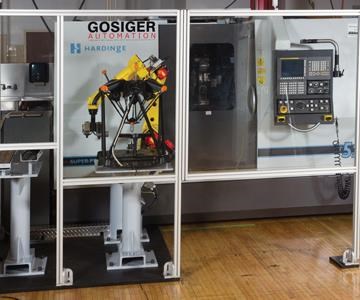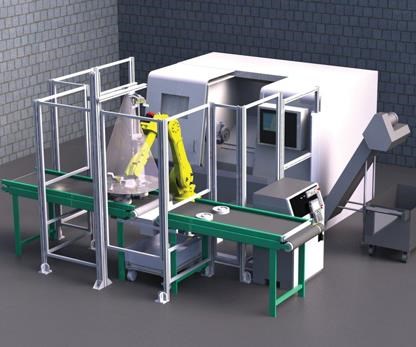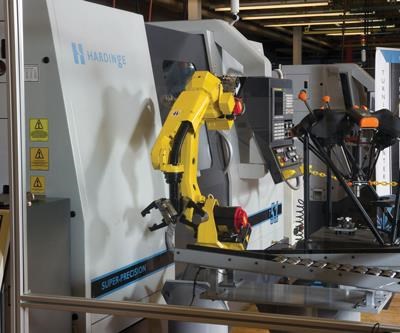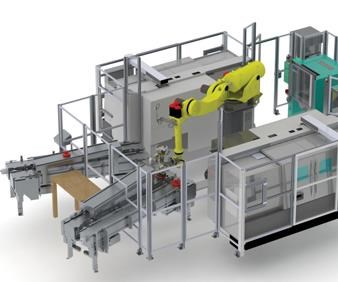Checklist for Lights-Out Manufacturing
Many shops of various sizes are trying to hop on the lights-out bandwagon. This article looks at some things to consider and check out before “hopping.”
The prospect of making parts overnight with little or no labor cost is tempting to any CNC machine shop. It’s easy to understand why: Competition is keen
and customers demand better parts and products to be available precisely when they need them—and at the lowest possible price.
Meanwhile, the cost of materials, utilities, labor and employee benefits continue to spiral upward. So the idea that a manufacturer can turn off the lights and go home every night while unattended mechanical minions crank out parts is an intriguing concept.
Modern technology, in fact, makes it possible to implement lights-out production not just for large manufacturing operations, but also for small CNC shops. However, there are a number of issues that must be considered before embarking on this journey. In this article, several important factors are highlighted, with suggestions provided to help develop a workable plan to go lights out.
Advantages to Lights-Out
The big picture objective of lights out is to reduce labor costs, but there are other potential savings as well.
First, planning long, overnight runs for the overnight shift can make a shop’s fully manned machine time more flexible. The idea is to do more short runs that require intervention for change-overs, work monitoring of more complicated parts, and the ability to respond to a customer’s urgent order can be accomplished during the day shift.
Also, machine operators can use their time more efficiently by setting up for overnight production, while daytime runs are in progress.
Last, power companies often charge less for energy used during off hours (overnight), so it may cost less to operate machinery during lights-out production.
Considerations
Assuming that the kinds of parts being produced during lights-out manufacturing lend themselves to unattended operation, there are some fundamental issues to consider.
Reliability of equipment. Since there won’t be anyone on-site to address machinery malfunctions, the machine tools, peripherals and automation equipment designated for the production run must operate flawlessly. Questions to ask regarding the shop’s capabilities cover machine tools, chip and coolant management and material loading/unloading.
Machine tools. Is the machine capable of continuous operation? Is it highly stable and rigid? Does it have appropriate spindle power? Does it have enough tooling stations to automatically provide an adequate supply of cutting tools? Is the control system capable of monitoring activities and either auto-correcting or remotely communicating problems? Does it have built-in thermal compensation and crash avoidance technology?
Chip and coolant management. Can the chip conveyor adequately handle the quantity and types of chips produced throughout the production run, or will the chips begin to back up and create problems? Can the conveyor efficiently filter coolant to prevent fines from contaminating the cutting fluid and potentially clogging coolant delivery nozzles or causing a pump breakdown? If high-pressure coolant delivery is required, can the delivery system be programmed to vary the pressure throughout the machining cycle as necessary?
Material loading/unloading. The two most common loading methods are bar feeders for loading barstock, and robots for just about everything else. If loading barstock, is the feeder capable of holding an adequate amount of material in its magazine or holding tray to supply the run? Does it have the ability to continuously feed and support barstock in synch with the machine tool to eliminate crashes? If running a family of parts, can it communicate with the machine tool program schedule and automatically adjust itself to a new part? Is it sturdy enough for continuous operation? Once the cycle is completed, can the part simply be pushed out of the machine tool into a bin? Is a vacuum unloader required to help protect part finish? Is a robotic arm or other device called for to unload the machine tool?
Planned preventative maintenance. Although such a program is invaluable regardless of whether or not lights-out manufacturing is performed, it’s extremely critical for overnight operation. If a machine goes down at any time, it’s a problem, but if machine operators are present, they can shift production schedules or use other machines until help arrives. When a machine breaks down in the middle of a lights-out shift, work grinds to a halt and precious run time is lost until someone is available to correct the problem. Whether using an in-house plan or contracting with a reliable service provider, a preventive maintenance program is critical for lights-out operations.
Remote monitoring. Although using reliable equipment and following a planned preventive maintenance program will minimize problems, there is always the possibility of machine failure, cutting tool breakage, power outages and other unexpected issues. That’s when having a remote monitoring system is invaluable. Many CNC machine controllers and peripheral equipment are designed to work with Ethernet or other communications tools that can send alerts to PCs or mobile devices located anywhere they are needed. A number of manufacturers use MTConnect for universal connectivity. It is, essentially, a common translator based on Internet standards that enables CNC and non-CNC machine tools and other shopfloor equipment to communicate with each other and with a central production monitoring system.
Commitment. For lights-out production to work, everyone must be on board, from management and the machine operators to the support staff. It’s a cultural change for many companies, and change always carries with it an element of fear. So it’s critical to make certain everyone in the organization understands the plan, their roles in it, and what it means for their future and that of the company.
A Role for Robotics
Robotic technology continues to advance, and capabilities currently include a number of other functions.
Using vision systems, robots can sort parts by size, color and by reading bar codes on the parts. Programming robots has also become easier, as has integrating the robotics with “smart” machine tool controls available on many current machine tools. In the near future, it is expected that some robots will be programmable via voice commands.
Whether used for lights-out or lights-on production, robotic-based automation has enormous potential to reduce labor costs, improve capital utilization, improve quality and increase productivity for companies of all sizes. Yet, it is estimated that in the U.S., robots are used in fewer than 10 percent of potential applications. This means there is great potential for manufacturers to leapfrog their competition through robotic-based automation.
What to Run
Not every application lends itself to lights-out manufacturing. Some parts are simply too complex to successfully manage without operator intervention.
While evaluating applications for automation, it’s important to know these facts about automation: machine tools and fixturing are automation capable; machine tools are dedicated to specific parts or parts families; families of parts share common machining processes; customers issue repeat orders; machining processes are stable or controllable; production is slowed by operator intervention; machine tools are not fully utilized; and part quality is inconsistent because of operator influence.
The most adaptable CNC machines for lights-out production are grinders, horizontal and vertical machining centers, multifunction lathes and two- and four-axis lathes. To ensure the system holds accuracies throughout the lights-out period, many manufacturers use process control devices appropriate to the machine tools and applications. These may include jump-on gages, probes mounted in the machine tool, CMMs (coordinate measuring machines), and standard or custom automatic gaging systems.
Partnership
For the right lights-out plan, equipment selection, installation, training and customer support, turn to an experienced integrator. Increasingly, capital equipment distributors are being asked to do much more for the customer than simply providing machinery. Today’s complex manufacturing demands a collaboration between a full service vendor that can provide process engineering, material handling, programming coordination, monitoring and tooling, to name a few.
Related Content
Job Shop Discovers and Fills a Fishing Need
The promise of a product line for improved mounting of electronic fish finders led this Missouri job shop to an automated turning process.
Read MoreZoller Event Shines Lights on Shopfloor Connectivity
The company’s open house event highlighted smart manufacturing solutions from CAM to part.
Read More4 Bright Ideas for Effective Lights-Out Machining
Adopting lights-out machining involves considerations when a machine shop decides to move forward with the process. Here are some tips to a successful implementation.
Read MorePursuit of Parts Collector Spearheads New Enterprise
While searching for a small parts accumulator for Swiss-type lathes, this machine shop CEO not only found what he was looking for but also discovered how to become a distributor for the unique product.
Read MoreRead Next
Take the Highland Road
From programming to setup to production, this Ohio job shop plans everything it does around untended machining. The company has been refining the process for more than a decade and has become very good at it.
Read MoreA Tooling Workshop Worth a Visit
Marubeni Citizen-Cincom’s tooling and accessory workshop offers a chance to learn more about ancillary devices that can boost machining efficiency and capability.
Read More5 Aspects of PMTS I Appreciate
The three-day edition of the 2025 Precision Machining Technology Show kicks off at the start of April. I’ll be there, and here are some reasons why.
Read More

















.jpg;maxWidth=300;quality=90)








